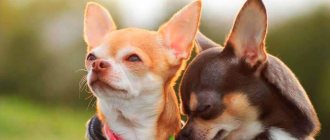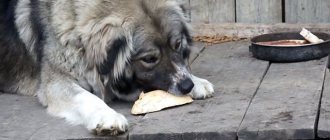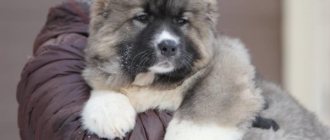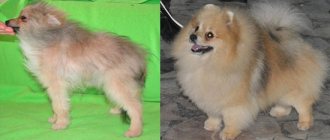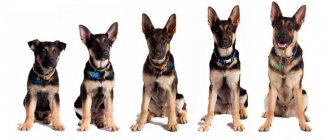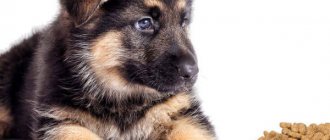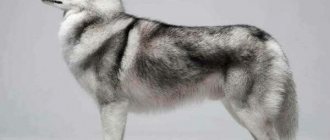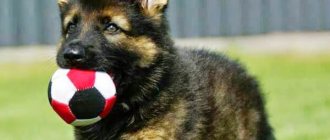Caucasian Shepherds are considered one of the largest dogs in the world, and their weight and size often exceed standard ones. The main thing that is required of the owner when raising and keeping a pet of this breed is to ensure that the weight and height of the animal are in the correct ratio and are not lower than the minimum standard limits.
Height and weight chart
| Age | Male weight (in kg) | Bitch weight (in kg) | Male height (in cm) | Bitch's height (in cm) |
| 1 month | 4-6,8 | 2,5-4,5 | 24-26 | 23-25 |
| 2 months | 13-19,6 | 11,5-18 | 34-37.5 cm | 33-35.5 cm |
| 3 months | 18-32 | 16,5-30 | 45-49 | 43-46 |
| 4 months | 25-60 | 22-50 | 51-55,5 | 48,5-51,5 |
| 5 months | 35-64 | 32-60 | 57-62,5 | 54-57 |
| 6 months | 40-94 | 35-92 | 63-68 | 59-63 |
| 7 months | 41,7-99 | 35,7-96,2 | 64-70 | 60-65 |
| 8 months | 43,4-104,4 | 36,5-100,6 | 65-72 | 61-67 |
| 9 months | 44,8-109,5 | 37,2-104,8 | 66-74 | 62-69 |
| 10 months | 46,2-114,6 | 38-109 | 66,5-75 | 63-70 |
| 11 months | 47,6-125 | 38,6-113,2 | 67,5-76 | 63,5-71 |
| 1 year | 50-125 | 40-115 | 68-78 | 64-72 |
How much does a Caucasian Shepherd dog weigh?
The spread in the parameters of this breed between the standard and the real one can be significant and increasing. It is important for the owner that his pet does not go beyond the minimum level.
If the animal’s weight exceeds the maximum, you need to make sure that the dog is really large and not overfed. To do this, compare the parameters of height and volume of the metacarpus. They must also not exceed the standards.
If the difference between real indicators and standard ones is significant, this indicates improper maintenance of the animal (underfeeding or overfeeding), deviations in the health of the animal - the presence of diseases. In these cases, you need to contact an experienced veterinarian.
From birth to 2 weeks
The initial stage of development begins at birth and lasts up to 7 weeks. The birth weight of Caucasians should be between 0.6 and 0.8 kg.
If a newborn kitten weighs less than 600 grams, it is simply naive to hope to get a large dog from it in the future.
An overly large puppy is also not a guarantee of its health. Before purchasing a pet that was born weighing more than 800 g, you must consult a veterinarian about congenital abnormalities in the animal.
Rapid growth in the first weeks of life is ensured by nutritious mother's milk
A newborn litter is small lumps, compact and inactive. They are active only when there is discomfort: experiencing hunger, dampness, cold, or painful sensations. At this time, the chicks have developed taste, smell, vestibular apparatus and skin-temperature reflexes.
Therefore, at first the little Caucasian is helpless, sleeps a lot, and often latches onto his mother’s nipples. The main food for him is milk. If the bitch has good lactation, and the litter is viable, which is expressed in its activity during sucking, then the daily increase from birth to four weeks of age is 113-200 grams.
Caucasians grow rapidly during this period. By two weeks they weigh from 2000 to 3880 g.
1 month
The period from 15 to 30 days is very important for dogs. At this time, auditory and visual perception of the world develops. Puppies begin to learn about objects around them. By this time they can already walk.
The height at the withers for girls should be at least 23-25 cm, for boys - 24-26. Measurements of the metacarpus during this period in females show 8-9 cm. In males, these figures are half a centimeter higher.
One-month-old young animals can already be given liquid complementary foods as an additive to mother's milk. Average weight from 4000 to 6800 grams. Moreover, girls have less mass than boys.
After a month, puppies continue to need mother's milk, but are already receiving their first complementary foods.
2 months
During this period, puppies begin to gain 400-420 grams daily. The weight of a two-month-old Caucasian Shepherd is from 13 to 19.6 kg.
Puppy age 2 months
3 months
For now, Caucasians are still clumsy and clumsy. But they are no longer as compact as newborns. Their limbs become elongated, their neck and torso become more oval, their head and chest enlarge. During this period, the Caucasian Shepherd puppy looks like a small bear cub.
The baby begins to develop conditioned and conditioned-unconditioned reflexes. At this time, it is recommended to begin training your pet, instilling basic skills in it, and teaching it simple basic commands.
He is still growing rapidly, gaining weight, and actively maturing. The daily increase ranges from 200 to 400 grams. A three-month-old puppy should weigh 18-32 kilograms.
The height at the withers according to the standard for females reaches 43-46 centimeters, for males - 45-49 centimeters. The volume of the metacarpus in girls is 11.5-12.5 centimeters, in boys the figures are 1 centimeter higher.
3 months - time to start actively training the puppy
4 months
From the age of three months to six months, the weight of a Caucasian Shepherd puppy should increase three times. During this period, the daily gain varies from 230 grams to 530. The weight of a four-month-old puppy can be 25-60 kilos.
Puppy age 4 months
5 months
The maximum weight of a five-month-old Caucasian is 64 kg, the minimum is 35 kg. It is already acquiring its basic color - the period of juvenile molting is ending.
The teenager's molars begin to grow, and his ears gradually rise. The pet is almost completely similar to an adult.
Puppy age 5 months
6 months
A six-month-old puppy weighs 40-94 kilograms. Its height at the withers reaches 63-68 cm in boys, 59-63 cm in girls. The volume of the metacarpus in females reaches 13-14 cm, in males - 14-15.5 cm. Now its appearance almost completely corresponds to an adult.
At this time, young bitches may begin their first heat. But dog experts and veterinarians do not recommend breeding large breed dogs until they are 2 years old. It is then that the bitch’s body completely matures.
Puppy age 6 months
7 months
After six months, animals grow less actively. In four weeks they gain from 1700 g to 5160 g. Daily gain varies from 57 to 172 g. A seven-month-old Caucasian weighs 41.7-99 kg. According to standards, the norm is 40-70 kilograms of live weight of the animal.
8 months
An eight-month-old individual weighs from 43.4-104.4 kg. The difference between the minimum and maximum indicators is explained by the parental genes, the health of the dog, its maintenance: feeding, used when exercising dogs with physical activity.
9 months
A nine-month-old adolescent shepherd can weigh between 44.8 kilograms and 109.5 kg. This is an almost fully formed individual. The animal is still growing, although not as rapidly as before.
10 months
Most of this breed grows to ten months of age. Having reached it, the pet looks like an adult.
A ten-month-old male dog can weigh a minimum of 46.2 kg, and a maximum of 114.6 kg.
At 10 months, a Caucasian Shepherd puppy looks like an adult
11 months
Some shepherds gain a little weight up to three years of age. This happens because with age, bones become stronger and muscles become denser. Therefore, even with identical volume parameters, the animal turns out to be heavier when weighed. The minimum weight for a male is 47.6 kg, for a female - 38.6.
Year
From six months to a year, the weight of a Caucasian Shepherd dog increases by only a third. The norm for females is 40-115 kg, for males - 50-125 kg.
The height of the Caucasian Shepherd at the withers for males becomes 68-78 cm, for females – 64-72. The volume of the metacarpus in girls reaches 14-15 cm, in boys - 15.5-16.5 cm.
From one to three years
The age of the shepherd is 2 years.
At one and a half years, the puppy’s growth stops, but its weight may increase a little more. According to standards, an adult Caucasian Shepherd weighs 45-50 kg.
But today there are increasingly deviations towards increasing the parameters of representatives of this breed. Very large individuals are often encountered.
Sometimes the weight of an adult Caucasian Shepherd Dog reaches 125 kg. This happens thanks to the selection work of breeders.
Up to 2 weeks after birth
At birth, puppies weigh between 600 and 800 grams. If a baby weighs less than the minimum limit, then he is unlikely to be able to grow into a large dog with strong bones and voluminous muscles. But puppies weighing more than 800 grams can turn out to be problematic in terms of health and, moreover, significantly outgrow the standard.
Newborn babies are inactive: they sleep most of the time and eat very often. At the same time, their daily weight gain ranges from 113 to 200 grams.
By the age of two weeks, the body weight of puppies is 2000–3880 grams.
Limbs
The forelimbs are perpendicular to the ground and are relatively far apart. Muscles are physically developed. Strong, close-fitting shoulders to the chest, together with wide shoulder blades, form an angle of one hundred degrees. The elbow joints are parallel to the surface and directed straight back. Short pasterns have an almost straight structure.
If you look at the dog from behind, you will see that the hind legs are perpendicular to the ground and are moderately far apart. The clearly visible hock and stifle joints are at an angle of one hundred and fifty degrees. The thighs, shins and metatarsals are well developed physically.
All limbs end in large rounded paws.
First month
Over the next two weeks, the shepherd pups begin to comprehend the world around them with the help of sight and hearing, and also gradually walk. By the thirtieth day of life, the height at the withers in boys of this breed is at least 24, and in girls it should be at least 23 cm. The weight of one-month-old puppies is 2500–6800 grams, while girls weigh less than their littermates.
Coat
The coat of the Caucasian Shepherd consists of three components: undercoat, guard hair and outer coat.
The undercoat consists of thin, soft-to-touch hairs that resemble down. It performs a warming function. Basically, the undercoat is clearly visible, but can be of different densities, depending on the conditions of detention and the influence of seasonal molting.
The guard coat is thick, straight, and rough to the touch. It is the main part of the coat and is evenly distributed throughout the dog’s body. The largest number of guard hairs is located on the back.
Cover hairs are rare, but distributed throughout the body of the Caucasian Shepherd. There are pores around each hair, the function of which is to saturate the animal’s skin with oxygen.
One of the largest dogs in the world has three types of hair:
- long (up to twelve centimeters, with a mane, feathering on the limbs, “pants” and a well-furred thick tail);
- intermediate (medium length, no fringes or “pants”);
- short (up to seven centimeters, without the presence of a mane, fringe or “pants”).
3rd month
Outwardly, at this age, small shepherd dogs become similar to bear cubs. They are still clumsy, but their legs have noticeably elongated, and their heads and chest have become more voluminous.
At three months of age, daily weight gain is 200-400 grams.
By the third month of life, the puppy weighs 18-32 kg, and the height at the withers is 45-49 cm in boys and 43-46 cm in girls. From the age of three months, the shepherd dog begins to develop conditioned reflexes, and this is the time that is considered the most suitable to begin systematic training of the pet.
Frame
The dog's physically well-developed body is quite wide and proportional. The straight line of the back ends in a short, slightly convex loin. The long, voluminous croup of the animal is slightly beveled towards the end (near the beginning of the tail). The voluminous, oval-shaped chest is well developed. The stomach is tightened thanks to developed muscles.
One of the largest dogs in the world, the tail is set high and crescent-shaped. When she is excited, she raises her tail high above her back. When calm, the tip of the tail reaches the hock joint.
From 1 year to 3 years
After one and a half years, the dog’s growth stops, but body weight can continue to increase until the age of three, until the animal reaches the full flowering of its physical development.
According to the breed standard, the average weight of an adult representative of this breed should be from 45 to 50 kg.
But in some very large dogs it can be 90 kg or more.
Head
The wedge-shaped shape of the dog's head ends with a wide base. The large and voluminous skull has an almost flat frontal part, which is divided in half by a shallow groove. The bump on the back of the head and the transition from the muzzle to the forehead (stops) are not particularly noticeable. The chewing muscles are well developed.
The large, wide, black nose does not protrude beyond the lines of the muzzle. The nostrils are moderately open.
The dog's voluminous muzzle tapers towards the nose. Its top line is parallel to the line of the forehead. Under the eyes, the animal's muzzle is well filled with well-developed muscles. The shepherd's muzzle ends with a powerful lower jaw and chin. Voluminous lips have distinct black pigmentation.
The standard allows for both scissor and level bites in Caucasian Shepherds. Typically, a complete set of teeth requires the presence of forty-two white teeth that are closely spaced together. Broken, knocked out teeth, missing first premolars (maximum two) are considered normal, but only if these flaws do not interfere with the determination of the bite.
The animal's eyes are of medium size, deep-set, wide and oblique. Black eyelids fit tightly to the eyeballs. Eye color can vary in intensity: from dark brown to hazel. The world's largest Caucasian dog always has a serious and attentive look, assessing the surrounding situation every second.
Small ears in the shape of a triangle hang on cartilage, and their inner part is very close to the dog's head. The ears are quite thick to the touch. Traditionally, they are docked (part of them is cut off). But the standard also allows uncropped ears.
The low-set neck of the animal is of medium length. The neck muscles are well developed. In males, the scruff of the neck is clearly visible.
What to do if it lags behind the norm?
Owners of Caucasian Shepherds should understand that each puppy is an individual and that all babies grow differently. If the shepherd dog continues to grow and develop, then there is a high probability that he will soon gain the missing weight. When we are talking about an adult dog or the gap from the norm exceeds 10% of the recommended weight, it is necessary to find out why this is happening.
The most common causes of weight loss:
- Heredity. If the puppy's parents are not large in size, then it is naive to expect that he will outgrow them. Also, the fact that the puppy is slowly gaining weight may be due to hereditary reasons. To make sure this is the reason, contact the breeder and ask how quickly your pet's mother grew and gained weight when she was the same age.
- Incorrect cultivation. It happens that a recently purchased puppy weighs less than normal. In this case, the cause of weight loss is often due to improper rearing in the breeder’s home. To solve this problem, it is best to consult a veterinary clinic, where experts will tell you how to feed the puppy correctly so that it quickly gains the missing weight.
- Illness or infestation by internal parasites. During illness, dogs often lose weight. If your pet has recently been ill with something serious, he may lose a lot of weight. In this case, it is recommended to contact a veterinarian to help you choose a more nutritious food for your pet or develop a natural feeding diet, and, if necessary, recommend antihelminthic medications.
- Insufficient physical activity. If a growing dog moves little, it cannot grow and develop properly, which can also cause weight loss. To solve this problem, it will be enough to devote more time to physical training of your pet.
Artificial methods of replenishing weight loss, in particular, adding supplements to the dog’s diet to increase muscle mass or strength training, such as running in a harness with weights, are completely unacceptable. Not only do they not contribute to the harmonious development of the pet, but they can also cause serious health problems.
Temperament
The world's largest dog from the Caucasus has all the necessary protective qualities: poise, confidence, courage, independence, and the ability to make its own decisions at a crucial moment.
The Caucasian Shepherd is infinitely loyal to its owner and his family and is ready to protect its “pack” from enemies until the end of its days. Always hostile towards strangers, but can restrain his impulse on the orders of the owner.
Diet
At different stages of its growth, your pet will require different diets:
- Babies eat quite often per month - breeders usually feed them about 5 times a day;
- At 2 months, puppies are gradually transferred to four meals a day;
- At 3 months, they gradually transition from four meals a day to three meals a day;
- 6-8 months – three meals a day;
- Up to a year, the dog is transferred to two meals a day;
- After a year, gradually teach your child to eat once a day - this is how adults eat.
In this case, you should get a table that shows the average weight of a puppy at different ages - compare the number of kilograms your pet gains per month with the average statistical data for this species.
Of course, the weight of a puppy may differ from classical standards - do not forget that this is a living creature that is difficult to squeeze into the framework of indicators and requirements. However, the general trends should still persist - if this is not the case, consult your veterinarian.
Key points in training
The stubborn, self-sufficient nature of the Caucasian Shepherd dictates the peculiarities of its training. The main qualities that a dog owner must have are willpower, perseverance, inflexibility and strong character. The dog obeys only unconditional authority and leader.
Training a Caucasian Shepherd should begin from the moment it appears in the house. Key points of training:
- establish rules of behavior and clear prohibitions;
- do not use physical force;
- do not raise your voice;
- do not rush the dog in the process of teaching commands;
- take a course of OKD and subsequently CS;
- accustom to a muzzle.
In the absence of experience, it is not recommended to train yourself. Caucasian Shepherds are intelligent and have a high level of intelligence. Learning and consolidation of skills occurs quite quickly. Therefore, an inexperienced owner may unknowingly “teach” the dog unwanted behavior.
It must be remembered that the most important period in the development of the psyche and physiology of an animal is the age of up to 9 months. The pet must complete basic training courses at this stage. Correcting mistakes made in raising a puppy is often beyond the power of even experienced dog handlers.
Read about how to properly train a dog in the article: “Training a puppy: effective methods from dog handlers, learning commands at home.”
List of prohibited products
After we have figured out the diet of Caucasian puppies, it will be useful to familiarize yourself with the list of foods that are contraindicated for puppies. This will allow you to avoid unpleasant situations when your pupil’s health may be in danger.
So, it is not recommended to give small Caucasians the following types of food:
- Pork meat - it is too fatty and can lead to intestinal upset;
- River fish – they contain parasites;
- Tubular bones - they can cause injury to the palate, gums and digestive tract;
- Sweets, spicy and salty foods;
- Poor quality dry food;
- Spoiled products - they can cause poisoning;
- Frozen food;
- Butter rolls, freshly baked bread;
- Potatoes, onions, spices.
